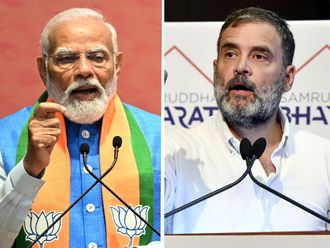Duba: In many ways, the post-poll scenario for the 2014 Lok Sabha elections may bear a striking resemblance to the political quagmire and bedlam that had bedevilled India in the wake of a hung parliament in 1996.
In the summer of 1996, neither Congress nor the Bharatiya Janata Party (BJP), the two major political forces, could manage to get anywhere near the magic figure, thereby throwing the door open for a ‘Third Front’ government. True, BJP was allowed to form a government because it was the single largest entity on the floor of the House. Yet, the Atal Bihari Vajpayee-led government lasted just 13 days, after it failed to garner of enough MPs and this allowed Congress to offer outside support to a 13-party coalition at the Centre.
Those messy days that preceded the formation of the United Front government under Haradanahalli Doddegowda Deve Gowda were marked by hectic parleys between more than a dozen political outfits.
While the then Communist Party of India (Marxist) general secretary, Harkishen Singh Surjeet, was the catalyst that helped bring political parties with disparate ideologies and manifestos under one roof, a character like Deve Gowda made a consensus choice for prime minister possible primarily because of his non-controversial nature and relatively universal acceptance among different interest groups.
Unfortunately, in the present-day scenario, there is neither a Surjeet nor a Deve Gowda to help galvanise non-Congress, non-BJP forces into a potent coalition that can run the country. If the recent opinion polls, conducted by a section of the electronic media in India, are anything to go by, a hung parliament in 2014 is a strong possibility, with neither Congress nor BJP likely to cross the 200-mark. This can create possibilities for a ‘Third Front’ to come into the race in a big way. Parties like Trinamool Congress, All India Anna Dravida Munnetra Kazhagam, Biju Janata Dal, Bahujan Samaj Party, Janata Dal (United) – to name a few are likely to account for a little over 200 seats in the 543-member Lok Sabha. This is most likely to see regional powerhouses like Mamata Banerjee, J. Jayalalitha, Navin Patnaik, Nitish Kumar, Mayawati getting into a huddle to explore possibilities of a non-Congress, non-BJP front. And given the kind of ego clashes and conflict of interests that are likely to ensue between these ambitious leaders, a compromise formula like Deve Gowda may be sorely missed. Deve Gowda has become virtually irrelevant in national politics, but the ‘Deve Gowda’ mould – that of a non-controversial, low-profile, soft-spoken consensus choice to stitch together a coherent alliance of clashing ideologues – is still very much relevant.
After stepping down as prime minister in April 1997 and paving the way for Inder Kumar Gujral as a compromise sop to Congress as United Front’s alternative choice for prime minister, Deve Gowda preferred to take a backseat in national politics, with little or no active role in any national debate. While his party Janata Dal (Secular) still has some relevance in Karnataka, in the corridors of power in New Delhi, Deve Gowda is a virtual nonentity and so is the ‘Deve Gowda’ brand of politics.
And that certainly does not augur well for coalition dynamics in the world’s largest democracy.












